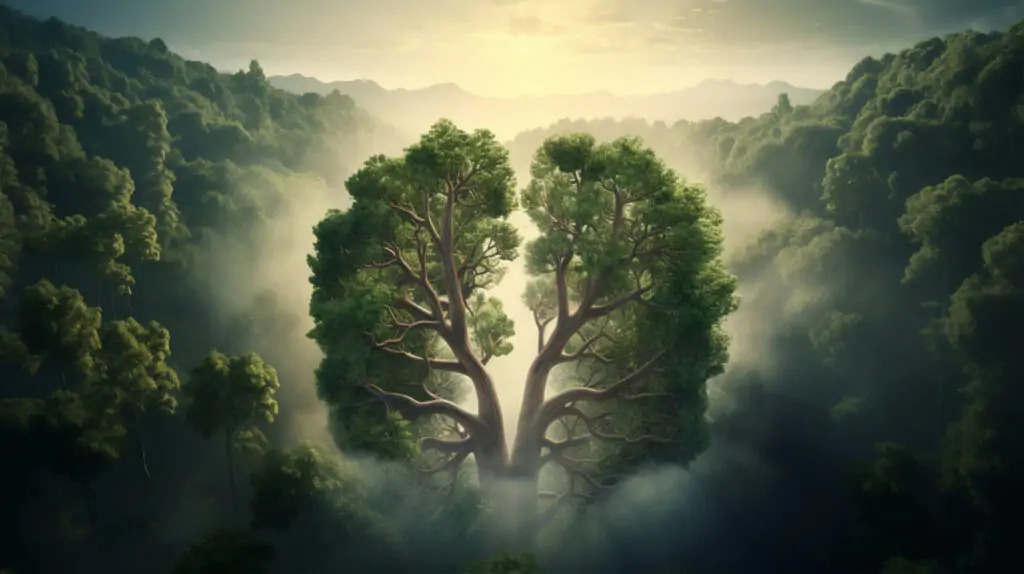Introduction
According to a recent study from Penn State, trees’ capacity to combat climate change is weakened in warmer, drier climates because they have a harder time absorbing carbon dioxide. According to the study, under these circumstances, stressed trees release more carbon dioxide through a process called photorespiration, which calls into question the effectiveness of trees as organic carbon sinks on a warming planet.
The lead author of the study, Max Lloyd, a senior research professor of geosciences at Penn State, stated, “We found that trees in warmer, less humid regions are essentially coughing rather than breathing.” The research was just published in the Proceedings of the National Academy of Sciences. “In colder, wetter conditions, they are releasing far more CO2 back into the atmosphere than trees do.”
Trees use photosynthesis to create new branches and remove CO2 from the atmosphere. But when trees are stressed, they release CO2 back into the atmosphere through a process called photorespiration. Through an investigation of a global dataset of tree tissue, the research group demonstrated that the rate of photorespiration is up to two times larger in warmer regions, especially when water is scarce. They found that in subtropical regions, typical daytime temperatures over around 68 degrees Fahrenheit surpass the threshold for this reaction, and the reaction worsens with further temperature increases.
The Difficult Function of Plants in Adapting to Climate Change
The results disagree with a prevalent idea about the function of plants in helping to pull down, or consume, carbon from the atmosphere, offering new insight into how plants may adapt to climate change. Most importantly, the researchers warned that as the climate heats, their findings suggest that plants might be less able to suck CO2 out of the atmosphere and assimilate the carbon essential to helping the world cool down.
We have upset this essential cycle, according to Lloyd. “Climate and plants are related to one another. Photosynthesizing organisms are the main source of CO2 loss in our atmosphere. Since it controls an important percentage of the atmosphere’s composition, even little adjustments have a significant effect.
According to the U.S. Department of Energy, plants presently absorb around 25% of the CO2 released by human activity annually. However, Lloyd warned that as the climate heats, this proportion is anticipated to decline, particularly if water becomes scarcer.
Since CO2 is what plants breathe in, it makes sense that it will rise when considering future climatic scenarios, according to Lloyd. However, as we’ve demonstrated, there will be a trade-off that some popular models fail to take into consideration. As a result of global warming, plants will have a reduced capacity to absorb CO2.
Researchers at Penn State led a team that used an analysis of a worldwide dataset of tree tissue to show that, in warmer climes, especially in situations when water is scarce, trees may photorespirate at a rate that is up to two times higher. They discovered that in subtropical regions, such as this area of the Appalachian Ridge and Valley Region, the threshold for this reaction is passed at average daytime temperatures above around 68 degrees Fahrenheit, and it gets worse as temperatures increase even higher.
Researchers found that a tracer of photorespiration in trees is a fluctuation in the quantity of certain isotopes of a component of wood called methoxyl groups. Lloyd clarified that isotopes may be thought of as different types of atoms. Atoms can have distinct isotopes with their own distinct “flavours” owing to differences in mass, much as you can have chocolate and vanilla ice cream. To investigate variations in photorespiration, researchers determined the amount of the methoxyl “flavour” of isotope in wood samples from around thirty tree species from various regions and situations throughout the world. The specimens come from an archive at the University of California, Berkeley, which houses hundreds of wood samples gathered in the 1930s and 1940s.
“We effectively rebuilt these forests to see how well they were absorbing CO2,” explained Lloyd. “The database was initially used to train foresters how to recognise trees from different places around the world.”
According to Lloyd, it was practically impossible to examine the pace at which plants take down carbon at scale or in the past since photorespiration rates could only be evaluated in real-time using living plants or preserved dead specimens that contained structural carbohydrates.
Looking to the Past to Understand the Future
Now that the team has verified a method for measuring photorespiration rate using wood, he believes the technology will provide researchers with a tool for forecasting how well trees will “breathe” in the future and how they performed in previous climates.
According to the National Oceanic and Atmospheric Administration, the quantity of carbon dioxide in the atmosphere is fast increasing and is already higher than it has been in the past 3.6 million years. However, Lloyd stated that the epoch in question is rather recent in geologic time.
Using fossilised wood, the scientists will now attempt to uncover photorespiration rates from the distant past, up to tens of millions of years ago. With the use of these techniques, scientists will be able to directly examine current theories about how plant photorespiration has changed throughout geologic time and its impact on climate.
“I used to work as a geologist,” Lloyd remarked. Thus, using living plants is not an option if we are interested in answering these huge issues about how this cycle functioned when the environment was considerably different from what it is today. In order to have a greater understanding of what our future could hold, we might need to travel back millions of years.
Conclusion
The most recent research from Penn State shows the challenging situations that plants face while combating the weather trade. It gets harder for plants to effectively absorb carbon dioxide when temperatures increase and regions are dryer. Stressed trees produce more carbon dioxide through photorespiration, which is like coughing instead of breathing, rather than serving as carbon sinks. This finding puts doubt on previous ideas on the contribution of trees to decreasing climate change and emphasises the critical need for effective strategies to protect and preserve our forests.
FAQ's
Q: Why are trees finding it harder to absorb carbon dioxide?
A: Due to stress brought on by rising temperatures and drier regions as a result of climate change, plants find it more difficult to efficiently absorb carbon dioxide. A process known as photorespiration results in an enhanced release of carbon dioxide as a result.
Q: What is photorespiration?
A: Plants release carbon dioxide during photorespiration, a metabolic activity, as opposed to absorbing it during photosynthesis. When plants are under stress, as they are in warmer, drier regions, it happens.
Q: How does this impact efforts to combat climate change?
A: The results cast doubt on earlier theories on trees’ function as carbon sinks by indicating that they may grow less effective at absorbing carbon dioxide from the atmosphere. It thus emphasises the necessity of taking immediate action to slow down climate change and save our forests.
Q: How was the study conducted?
A: The researchers investigated a worldwide collection of tree roots to examine the spatial patterns of photorespiration. Photorespiration rates are higher in warmer, drier climates, indicating greater tree hardiness, the researchers said.
Q: What are the implications for the future?
A: Developing useful strategies to mitigate climate change requires understanding how climate change affects the ability of trees to absorb carbon dioxide to protect our forests and their potential to mitigate the effects of climate change. The study highlights the importance of many exploration and conservation applications.





